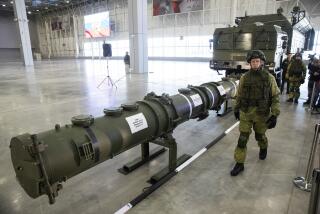No Finish, but a Start--and a Great One : Bush, Gorbachev make a very significant political decision
“Depend upon it, sir,” said Samuel Johnson, “when a man knows he is to be hanged in a fortnight, it concentrates his mind wonderfully.” Depend upon it, too, when a couple of shrewd politicians like George Bush and Mikhail S. Gorbachev want a reason to engage in conspicuous summitry in a few weeks’ time, they won’t let a little thing like seemingly unbreakable deadlock over the arcane details of a strategic arms reduction treaty stand in their way. And so, just before they parted in London after Gorbachev’s appearance before the Group of Seven, the presidents of the United States and the Soviet Union struck a deal. They have ordered their negotiators in Geneva to wrap up nine years of work by July 30, the day Bush is to arrive in Moscow, so that the START treaty will be ready for signing as the probable high point of their summit meeting.
It will be an achievement worth celebrating. In 700 pages of abstruse technical analysis and requirements the two countries agree to make the first cuts ever in their long-range nuclear arsenals. Previous arms agreements have only limited the growth in nuclear weapons or--in the case of the Intermediate-range Nuclear Forces Treaty signed in December, 1987--cut missiles of much shorter range. The START treaty goes for the real muscle, for bomber-carried strategic weapons and land-based multi-warhead missiles.
The START treaty will set in motion cuts of about 35% in the number of warheads on Soviet long-range nuclear weapons and 25% in U.S. warheads. Those are big numbers, but they won’t exactly leave the two countries denuded of strategic nuclear power. When the treaty is fully implemented, probably in 1999, the United States will still retain roughly 9,000 warheads, the Soviets 7,000. Anyone who fears that this represents a heedless rush toward disarmament should note the comment of former U.S. arms negotiator Raymond Garthoff, now a defense analyst at the Brookings Institution. What the two sides will be left with in 1999, Garthoff says, are more strategic warheads than they had when START talks began in 1982.
The treaty says that no more than 4,900 warheads on each side can be on intercontinental missiles and submarine-launched ballistic missiles. That will ultimately leave the Soviets with more ground-based ICBMs than the United States, but the United States will continue to hold a clear advantage in sea-based missiles.
Should there be a START II? Of course, for clearly enormous cuts in strategic nuclear arsenals can still be made without jeopardizing the national security of either country. Will there be a START II? Possibly. A lot must obviously depend on political events in the Soviet Union. An unmistakable turn toward truly representative government and a market economy would almost automatically assure that Soviet spending and resources would be reallocated away from the longtime emphasis on military production. And a more open Soviet society would lessen concerns about effective inspection and verification of arms levels.
Meanwhile, the significance of START I should not be scanted. It represents one more important step toward further reducing U.S.-Soviet tensions and strengthening that elusive but vital foundation of trust that makes understandings and agreements possible. The dedication and contributions of the technicians who have labored for so long in Geneva over this incredibly complex treaty--the U.S. team numbers about 70, the Soviet 50 or 55--have been impressive. But at the end of the day it was political judgments, not technical decisions, that brought the treaty to fruition.
Apprised of how close their specialists had come to an agreement, George Bush and Mikhail Gorbachev gave orders to close the final gap. And so, at long last, it is being done.
More to Read
Sign up for Essential California
The most important California stories and recommendations in your inbox every morning.
You may occasionally receive promotional content from the Los Angeles Times.










